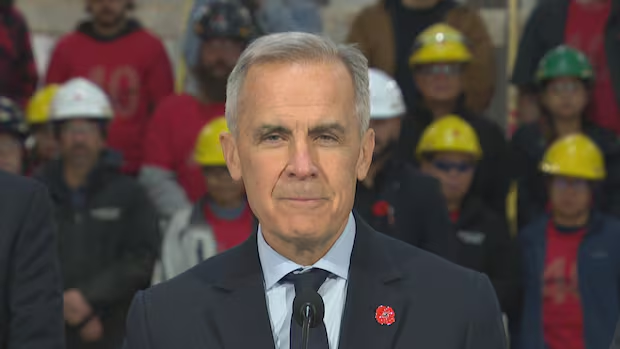Long-delayed Sisson Mine in running for Carney’s national projects list

Listen to this article
Estimated 5 minutes
The audio version of this article is generated by text-to-speech, a technology based on artificial intelligence.
New Brunswickers will find out Thursday how much of a poker face Prime Minister Mark Carney has.
During a visit to Fredericton on Monday, the prime minister smiled broadly — and cocked his head as if about to reveal a secret — when he was asked why the proposed Sisson Mine wasn’t on his initial “projects of national interest” list released in September.
Carney said more projects would be added on Thursday, including one from the province.
“I’ve had a number of conversations with the premier about major projects here that meet the criteria,” he said.
“They strengthen Canada’s autonomy. They diversify our economy. They’re built with Indigenous partners. They’re consistent with our climate goals. And they have a real economic return.”
Projects that earn the federal designation can benefit from a range of advantages, including accelerated regulatory approvals, federal funding and other forms of support designed to get them moving quickly.
The proposed Sisson Mine project, more than a decade old, would extract tungsten and molybdenum, two critical minerals used for energy storage and production and military applications.
WATCH | ‘A real economic return’: Carney coy on N.B. mine pitch:
A look at the Sisson Mine, one of N.B.’s proposed ‘national’ projects
Major mineral development north of Fredericton could benefit from G7 plan to compete with China
It has already obtained federal and provincial environmental approvals but may be in line for other help to make the project less of a risk for investors.
Since Carney’s comments on Monday, Holt has been asked repeatedly what project Ottawa has chosen and has responded that she didn’t want to “scoop” the prime minister.
The premier knows what the choice is, but all she would say is that it’s not electricity transmission connections through New Brunswick linked to Nova Scotia’s Wind West project.
I’m really looking forward to tomorrow’s announcement so that I can stop dancing around the question.– Premier Susan Holt
“I’m really looking forward to tomorrow’s announcement so that I can stop dancing around the question,” Holt said Wednesday in Edmundston.
New Brunswick submitted several project proposals for consideration, but the timing for Sisson looks good.
Ottawa said in May it was willing to put up $8.2 million to support the project, and the proponent, Northcliff Resources, said in May the U.S. government was awarding it $20.7 million to advance development.
Carney visited Fredericton on Monday and met with Premier Susan Holt in her office. (Mikael Mayer/Radio-Canada)
The Carney government’s budget last week included a new “critical minerals sovereign fund” with $2 billion over five years for strategic investments.
And last month energy ministers from the Group of Seven major industrialized countries met in Toronto to push forward with their “Critical Minerals Production Alliance,” a co-ordinated effort to support development in the sector.
The goal is to create alternate sources of critical minerals so that China doesn’t effectively control the global supply — and wield influence over procurement and prices.
Reuters reported in September that G7 leaders were looking at setting a price floor for the minerals to ensure proposed mines had enough of a business case to attract investors.
A price floor “helps us strategically, in competition with China, that has 80 per cent of the tungsten market tied up,” Holt said Wednesday.
If developed, the Sisson Mine would be in operation for about 27 years and cost an estimated $579 million. (Submitted by Sisson Mining Ltd.)
“Being able to have a price floor established by the Canadian government secures the value of the resource as well as our ability to develop it.”
She said another possibility is an offtake agreement — essentially, a guarantee to investors that there will be a buyer of the mine’s product.
The project is 88.5 per cent owned by Northcliff, with New Zealand’s Todd Corporation holding 11.5 per cent.
The province approved the project under its environmental impact assessment process in 2015, with 40 conditions attached.
Environmental critics say Northcliff has yet to comply with some of those conditions, and New Brunswick has twice extended the deadline for the start of construction.
That deadline is up again next month.
Holt said Wednesday her government was pushing for all the conditions to be met so the mine can proceed.
Federal approval came in 2017, the same year Wolastoqey chiefs who had opposed the mine signed what the province called an “accommodation agreement” on the project.
That agreement would see the six First Nations receive 35 per cent of the first $2 million in provincial mine royalties each year, and 3.5 per cent of everything above that.
The chiefs said at the time they had to sign on to get the government to renew tax-sharing agreements for on-reserve gas and tobacco sales revenue for another decade.
Blaine Higgs, the Progressive Conservative premier at the time, terminated the tax agreements in 2021, but the new Holt Liberal government recently signed new deals with roughly the same terms.
Natural Resources Minister John Herron said earlier this year that his goal is to ensure First Nations get equity stakes — a share of ownership — in major projects.
A decade ago, the project was estimated to be worth $579 million and was likely to generate $280 million in royalties to the province over the mine ’s 27-year lifespan.
It would employ 500 people during construction and 300 during regular operations.





